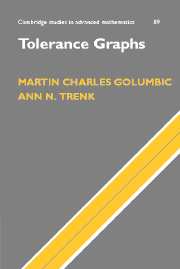Book contents
- Frontmatter
- Contents
- Chapter Dependencies
- Preface
- 1 Introduction
- 2 Early work on tolerance graphs
- 3 Trees, cotrees and bipartite graphs
- 4 Interval probe graphs and sandwich problems
- 5 Bitolerance and the ordered sets perspective
- 6 Unit and 50% tolerance orders
- 7 Comparability invariance results
- 8 Recognition of bounded bitolerance orders and trapezoid graphs
- 9 Algorithms on tolerance graphs
- 10 The hierarchy of classes of bounded bitolerance orders
- 11 Tolerance models of paths and subtrees of a tree
- 12 φ-tolerance graphs
- 13 Directed tolerance graphs
- 14 Open questions and further directions of research
- References
- Index of Symbols
- Index
4 - Interval probe graphs and sandwich problems
Published online by Cambridge University Press: 11 August 2009
- Frontmatter
- Contents
- Chapter Dependencies
- Preface
- 1 Introduction
- 2 Early work on tolerance graphs
- 3 Trees, cotrees and bipartite graphs
- 4 Interval probe graphs and sandwich problems
- 5 Bitolerance and the ordered sets perspective
- 6 Unit and 50% tolerance orders
- 7 Comparability invariance results
- 8 Recognition of bounded bitolerance orders and trapezoid graphs
- 9 Algorithms on tolerance graphs
- 10 The hierarchy of classes of bounded bitolerance orders
- 11 Tolerance models of paths and subtrees of a tree
- 12 φ-tolerance graphs
- 13 Directed tolerance graphs
- 14 Open questions and further directions of research
- References
- Index of Symbols
- Index
Summary
Physical mapping of DNA
The use of interval models in molecular biology dates back to the original studies on the linearity of genes by the well-known biologist Seymore Benzer. In Benzer (1959), interval graphs were defined in order to study overlap data on sub-elements inside the gene. The question at that time was whether the overlap data was consistent with the hypothesis that genes are linear structures with the sub-elements being intervals on that line. If perfect and complete data were to be available for of all pairs of these sub-elements, then the problem would be that of recognizing an interval graph. However, with only partial data, as is always the case in experimental genetics, the problems involve embedding the data in a larger consistent set (e.g., interval graph completion). This will generally require inferring additional intersections (e.g., selectively adding chords to a cycle), and using additional biological information or assumptions to test consistency and propose the possible linear orderings.
During the ensuing years, research in genetics has involved many combinatorial problems on intervals. One of these is DNA physical mapping, in which one wishes to find the linear order of segments (physically contiguous units) of the chromosome. It is an essential part of most sequencing, gene locating, and cloning projects. One of the main goals set for the Human Genome Project is to obtain a detailed mapping of all human chromosomes.
- Type
- Chapter
- Information
- Tolerance Graphs , pp. 63 - 83Publisher: Cambridge University PressPrint publication year: 2004



